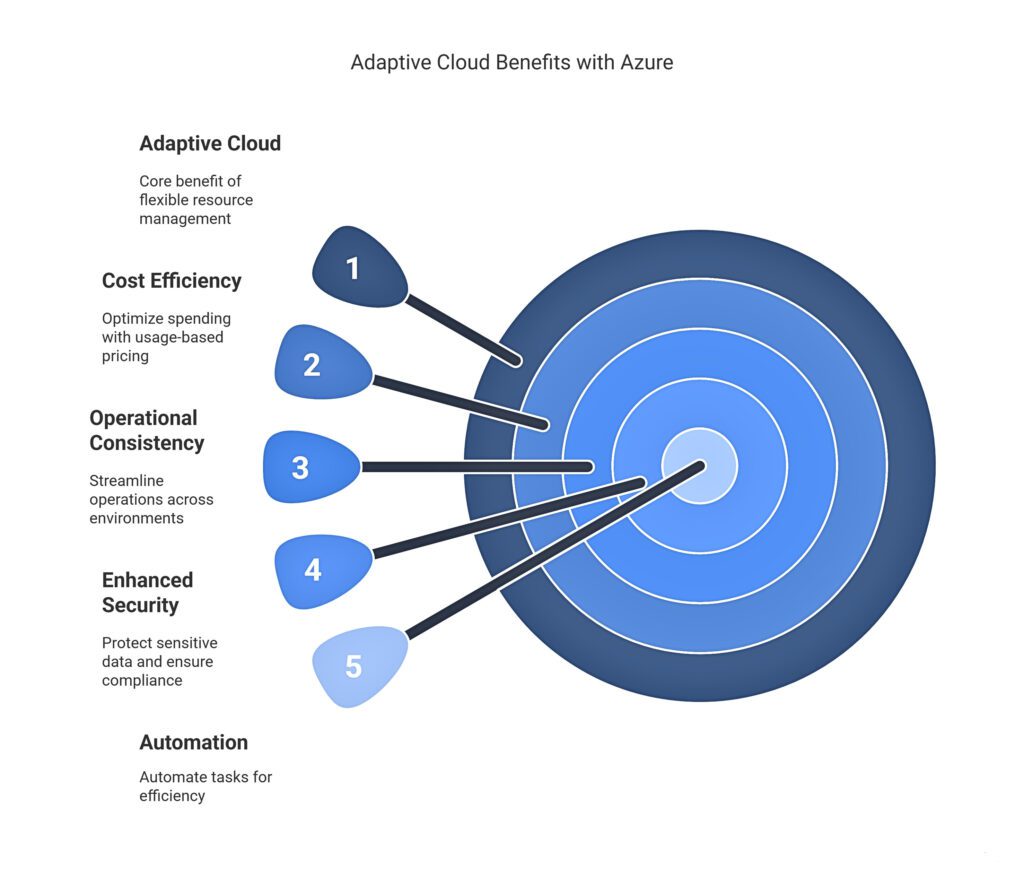- April 11, 2025
Technology has evolved enormously with fluctuations in the economic landscape in the last three years. Organizations in every industry are striving to innovate and adapt. As we enter the era of AI, the pace of change is set to accelerate even further.
However, they require standard innovation platform like Microsoft Azure cloud to perform different tasks and initiatives as per their business requirements. Advancing hybrid cloud to adaptive cloud with Azure ensures boosting innovation and expanding your capabilities to address challenges with agility and perfect assistance.
This article provides you with a guide on advancing hybrid cloud to adaptive cloud with Azure service providers leveraging cloud-native and AI technologies.
Let’s explore!!
Brief Understanding of Hybrid Cloud & Adaptive Cloud with Azure

Hybrid Cloud: Hybrid Cloud is a computing environment that combines on-premises infrastructure with public cloud services, allowing data and applications to be shared between them. A hybrid cloud approach enables businesses to leverage the benefits of both on-premises and cloud environments, providing greater flexibility, more deployment options, and optimized existing infrastructure investments.
Adaptive Cloud: Adaptive cloud refers to a dynamic cloud computing model that adjusts to the needs of the business, workloads, and applications in real time. This concept goes beyond traditional hybrid cloud setups by incorporating advanced automation, artificial intelligence, and machine learning to optimize cloud resources continuously.
3 Challenges Organizations Specifically Confront
- Resource Overload: Companies are drowning in devices and servers, with the growth of edge computing, IoT, and multi-cloud deployments. Simple tasks like patching, configuration, and security become incredibly difficult as the sprawl continues.
- Innovation Silos: Different departments are innovating quickly, but often on their own, without sharing knowledge or collaborating. This leads to duplicated efforts, wasted resources, and increased security risks. IT, development, and operational technology (OT) teams often operate independently, rolling out modern technology without coordination. Over time, talent gets stuck working with specific projects or technologies, limiting their overall impact.
- Technical Debt Trap: Focusing on quick fixes instead of long-term strategies creates incompatible systems. Valuable data gets locked away, unable to be used to improve the business because it is trapped in its silo.
The necessity for a unified platform to tackle these challenges is clear. Azure cloud services is the best solution and Microsoft has heavily invested in Azure Arc to address these issues. They claim to have recognized the potential to enhance their offerings by combining agility with intelligence, enabling our customers to proactively adapt to changes and sustain a competitive advantage in an ever-evolving environment.
Detailing the Adaptive Cloud Approach for Azure
The adaptive cloud approach integrates siloed teams, distributed locations, and expansive systems into a unified model for operations, security, applications, and data. This consolidation allows organizations to harness cloud-native and AI technologies, enabling seamless collaboration across hybrid, multi-cloud, edge, and IoT environments.
Adopting an adaptive cloud approach transforms organizations from being reactive to proactively evolving. It enables them to anticipate and respond to market trends, customer needs, and technological advancements in advance. Such strategic foresight allows businesses to pivot swiftly, embrace continuous improvement, and seamlessly incorporate innovative technologies. Embedding resilience into their operational frameworks, businesses can optimize resource utilization and proactively address security and business risks.
Modernized Microsoft Azure Capabilities for Business Enhancement
Microsoft Azure services are advancing its adaptive cloud strategy by building on the foundation established with Azure Arc, an extension of Azure Resource Manager (ARM). Azure Resource Manager maintains comprehensive configurations, logs, and metrics for every resource in Azure, serving as a sole source of truth for your Azure investments. Microsoft Azure Arc allows you to project hybrid, multi-cloud, edge, and IoT resources into Azure Resource Manager.
Apparently, this integration not only creates a unified source of truth but also enables the straightforward application of cloud services across your globally distributed digital assets. For instance, Azure’s observability tools, like Azure Monitor, provide visibility across thousands of assets in one centralized location. Our security solutions, such as Microsoft Defender for Cloud, Microsoft Sentinel, and Azure Policy for security enforcement, help you enhance and develop your security posture. Azure Arc already offers significant capabilities and is envisioning a future where AI can further amplify your impact across existing and new scenarios.
Key Benefits of Advancing Hybrid Cloud to Adaptive Cloud with Azure

- Elastic resources that easily scale workloads up or down based on demand.
- Deploy workloads in the most appropriate environment, whether on-premises or in the cloud.
- Scale out to the public cloud for high-demand periods without the need to invest in additional on-premises hardware.
- Keep sensitive data on-premises to comply with regulatory requirements while using the cloud for less sensitive data.
- Use Azure Arc to manage and govern resources across on-premises, multi-cloud, and edge environments consistently.
- Develop and deploy applications using consistent tools and processes across hybrid environments.
- Implement hybrid cloud disaster recovery solutions to ensure business continuity.
- AI-driven insights to predict workload demands and automatically scale resources accordingly.
- Automate routine tasks such as scaling, monitoring, and maintenance, reducing the need for manual intervention.
- Implement policies that automatically enforce compliance, security, and performance standards.
- Leverage advanced monitoring tools to proactively detect and resolve issues before they impact performance.
- Only pay for the resources you use, avoiding over-provisioning and underutilization.
- Use Azure Cost Management and Billing to gain insights into spending and optimize costs.
- Ensure consistent operations across different environments, reducing complexity and improving efficiency.
Conclusion
Adopting adaptive Azure cloud strategies, businesses can enhance visibility, improve security posture, and achieve greater operational efficiency. The adaptive cloud model ensures that resources are dynamically allocated and optimized in real-time, adapting to the ever-changing demands of modern business environments. As Azure cloud services continue to innovate, organizations can look forward to even more advanced tools and solutions that amplify their impact and drive sustained growth and innovation in the digital era.




